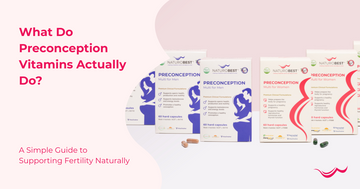
About 10% of known pregnancies end in miscarriage and that increases to 20% if you include unknown pregnancies.
Most early miscarriages occur because of chromosomal errors in either the egg or sperm. Yes, sperm aneuploidy exists. It is not only the health of the mother and her eggs that affects whether a pregnancy is viable or not. The health of the father and his sperm is also important.
Your eggs and sperm are at a higher risk of chromosomal damage if they are exposed to radiation. Radiation may be from pelvic x-rays, laptops on laps and mobile phones in pockets. Nutrient deficiencies also play a role in miscarriages.
Zinc and selenium deficiency may cause of chromosome changes due to the fact they are an essential component of genetic material. Therefore, zinc and selenium deficiencies (amongst other nutrients) are a direct cause of miscarriage.
Your risk of miscarriage is impacted by many factors.
A recent study showed that low total antioxidant status is associated with miscarriage. [1] CoQ10 is an excellent antioxidant, often used by women who are trying to conceive. In naturopathic medicine, it is especially recommended for older mothers aged 35+.
Are you taking the right type of folate?
Most people confuse the word folate with folic acid and assume that folic acid comes from food but it does not. There are 3 types of folate:
Folic acid is the cheap, synthetic form found in supplements.
Folinic acid is an active form found in supplements and food.
5-methyltetrahydrofolate (5-MTHF) is the most active form of folate found in supplements and food like green, leafy vegetables.
MTHFR is an enzyme which is ultimately responsible for re-methylating homocysteine into methionine. This may sound a bit scientific and boring. Let me explain how this relates to pregnancy and your risk of miscarriage and neural tube defects.
When you go for an MTHFR blood test they will generally be checking for 2 genetic polymorphisms – C677T and A1298C. You can be either homozygous (inherited from both parents) or heterozygous (inherited from one parent).
Taking a preconception vitamin is a good idea for at least 3-4 months prior to conception. A preconception vitamin that contains active folate, zinc, selenium and CoQ10 amongst other essential nutrients is important.
Neural tube defects
C677T is the one we are most interested in when it comes to folic acid metabolism. If you are homozygous for C677T you have a 70% reduction in your ability to metabolise folic acid into the active form of folate. This is why those women will be prescribed 5mg of folic acid by their obstetrician. If you are heterozygous you have a 40% reduction in your ability to metabolise folic acid into the active form (5-MTHF).
If you are homozygous, then you will still have a high risk of a neural tube defect, even if you are taking a standard prenatal multivitamin that contains 500mcg of folic acid.
If you take a supplement containing 500mcg of 5-MTHF, your risk is reduced. However, you will still need to seek professional advice as 500mcg of 5-MTHF is unlikely to be enough for you.
Miscarriage
Let’s get on to this homocysteine methylation. Homocysteine is an amino acid that naturally occurs in the body. High levels lead to thrombophilia. This is an increased risk of blood clotting which is a cause of miscarriage.
High homocysteine later on in life leads to an increased risk of heart attacks and stroke. It is important at all stages of life to keep this under control. We need adequate levels of vitamins B6, B12 and folate to ensure homocysteine levels stay in the normal range. Other nutrients need to be considered as well.
People who are homozygous or heterozygous for both C677T and A1298C are at an increased risk of high homocysteine levels. As well as the risks associated with high homocysteine.
If you are homozygous for MTHFR C677T, you may be interested in a study that showed 800mcg of Quatrefolic® was better than 5mg of folic acid in reducing the risk of miscarriage.
It is clear that there is a lot to take into consideration when preparing to have a baby. A preconception care plan for both partners is vital when planning a baby. A preconception care plan should be commenced 4 months prior to conception. This is essential to increase the best chance of a successful pregnancy and a healthy baby.
Reference
- Omeljaniuk, W.J., et al., Antioxidant status in women who have had a miscarriage. Adv Med Sci, 2015. 60(2): p. 329-34.




